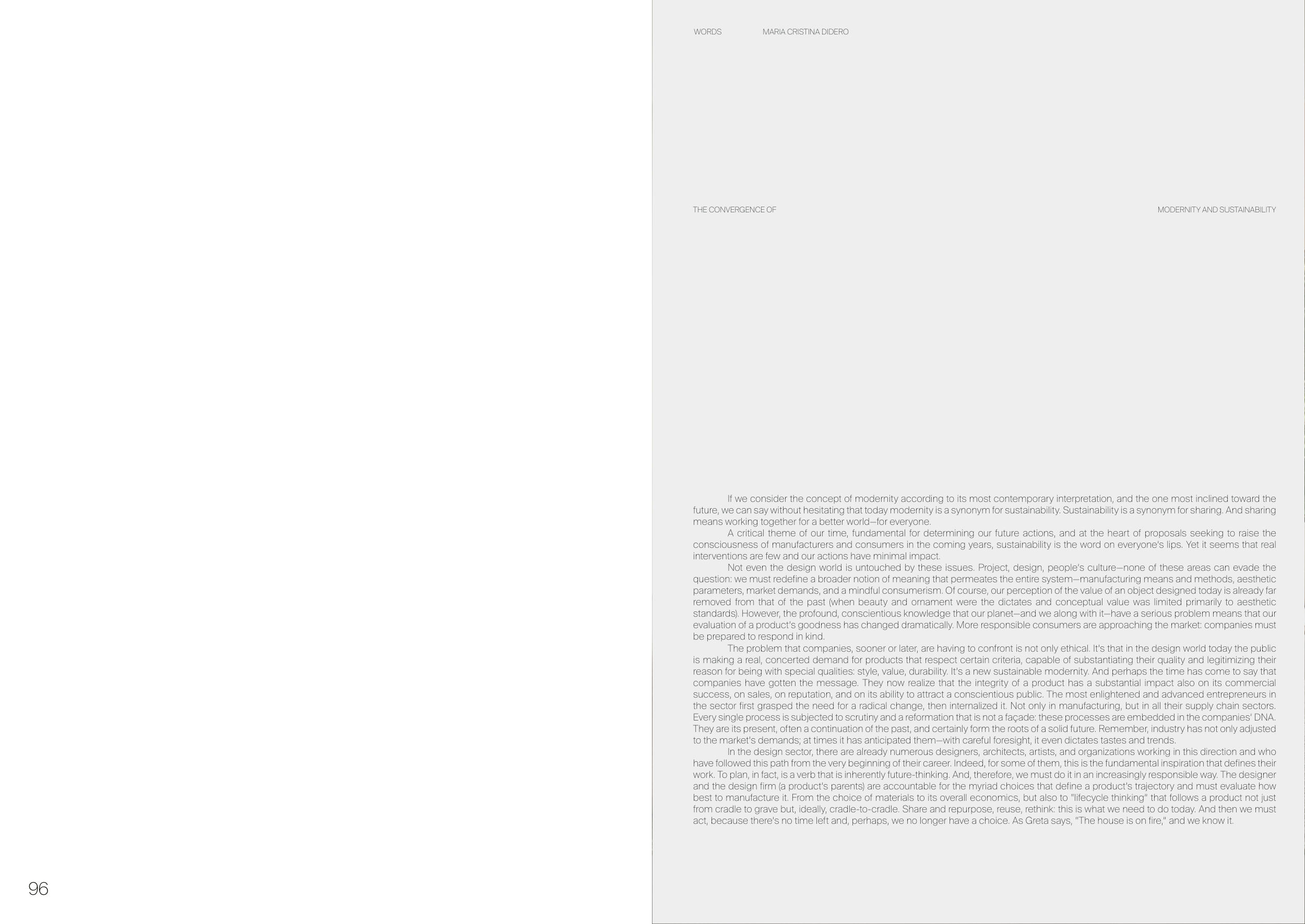97
96
Modern Stories_27 02 4 .indd 96-97
23/03/23 17:25
THE CONVERGENCE OF
MODERNITY AND SUSTAINABILITY
WORDS
MARIA CRISTINA DIDERO
If we consider the concept of modernity according to its most contemporary interpretation, and the one most inclined toward the
future, we can say without hesitating that today modernity is a synonym for sustainability. Sustainability is a synonym for sharing. And sharing
means working together for a better world—for everyone.
A critical theme of our time, fundamental for determining our future actions, and at the heart of proposals seeking to raise the
consciousness of manufacturers and consumers in the coming years, sustainability is the word on everyone’s lips. Yet it seems that real
interventions are few and our actions have minimal impact.
Not even the design world is untouched by these issues. Project, design, people’s culture—none of these areas can evade the
question: we must redefine a broader notion of meaning that permeates the entire system—manufacturing means and methods, aesthetic
parameters, market demands, and a mindful consumerism. Of course, our perception of the value of an object designed today is already far
removed from that of the past (when beauty and ornament were the dictates and conceptual value was limited primarily to aesthetic
standards). However, the profound, conscientious knowledge that our planet—and we along with it—have a serious problem means that our
evaluation of a product’s goodness has changed dramatically. More responsible consumers are approaching the market: companies must
be prepared to respond in kind.
The problem that companies, sooner or later, are having to confront is not only ethical. It’s that in the design world today the public
is making a real, concerted demand for products that respect certain criteria, capable of substantiating their quality and legitimizing their
reason for being with special qualities: style, value, durability. It’s a new sustainable modernity. And perhaps the time has come to say that
companies have gotten the message. They now realize that the integrity of a product has a substantial impact also on its commercial
success, on sales, on reputation, and on its ability to attract a conscientious public. The most enlightened and advanced entrepreneurs in
the sector first grasped the need for a radical change, then internalized it. Not only in manufacturing, but in all their supply chain sectors.
Every single process is subjected to scrutiny and a reformation that is not a façade: these processes are embedded in the companies’ DNA.
They are its present, often a continuation of the past, and certainly form the roots of a solid future. Remember, industry has not only adjusted
to the market’s demands; at times it has anticipated them—with careful foresight, it even dictates tastes and trends.
In the design sector, there are already numerous designers, architects, artists, and organizations working in this direction and who
have followed this path from the very beginning of their career. Indeed, for some of them, this is the fundamental inspiration that defines their
work. To plan, in fact, is a verb that is inherently future-thinking. And, therefore, we must do it in an increasingly responsible way. The designer
and the design firm (a product’s parents) are accountable for the myriad choices that define a product’s trajectory and must evaluate how
best to manufacture it. From the choice of materials to its overall economics, but also to “lifecycle thinking” that follows a product not just
from cradle to grave but, ideally, cradle-to-cradle. Share and repurpose, reuse, rethink: this is what we need to do today. And then we must
act, because there’s no time left and, perhaps, we no longer have a choice. As Greta says, “The house is on fire,” and we know it.


